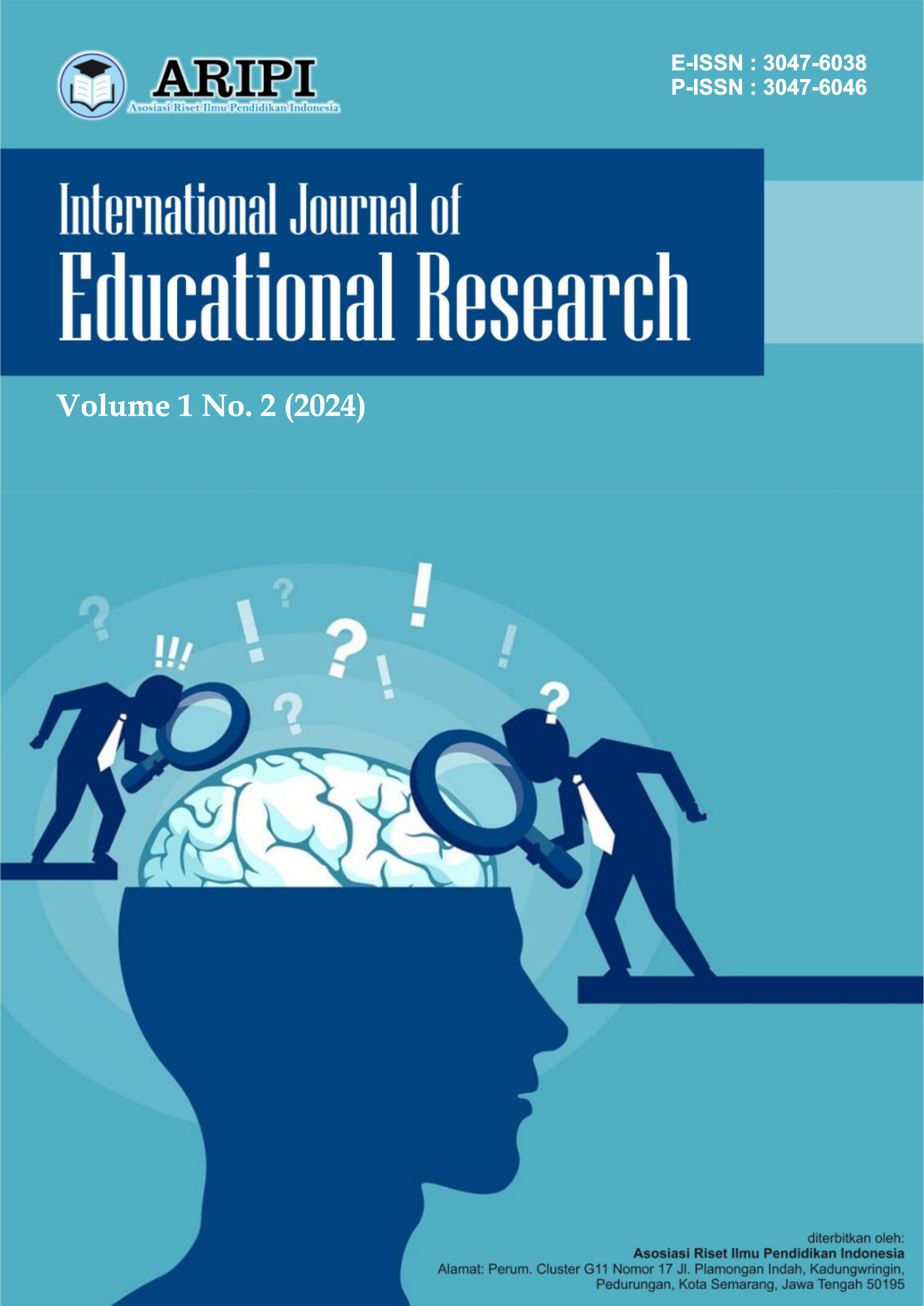Utilizing Maize Cob Media as a Replacement for Nutrient Agar Media in the Growth of Escherichia coli and Staphylococcus aureus Bacteria
DOI:
https://doi.org/10.62951/ijer.v1i2.23Keywords:
Corncob media, Escherichia coli bacteria, Staphylococcus aureus bacteriaAbstract
Bacteria are microorganisms that require adequate media and nutrients to grow and develop. The media commonly used to grow bacteria is Nutrient agar media, but the price of Nutrient agar media is quite expensive. Corn cobs are lignocellulosic wastes that contain nutrients that can meet the nutritional requirements of bacterial growth media. This study aims to investigate the viability of corn cobs as a cost-effective alternative to Nutrient agar media. Specifically, we explore the variance in bacterial colony growth when utilizing corn cobs as a growth medium for Escherichia coli and Staphylococcus aureus bacteria. Employing a true experimental design with a posttest-only control structure, we analyze the treatment's effects using the One Way ANOVA test and Independent Sample T-test. These statistical methods enable us to discern differences between groups utilizing corncob media with and without added sugar.Our findings reveal noteworthy insights into bacterial colony growth. For Escherichia coli, the average number of colonies on corncob media with sugar was 222 CFU/ml, on corncob media without sugar, it was 164 CFU/ml, and on Nutrient agar media, it reached 361 CFU/ml. In the case of Staphylococcus aureus, colonies on corncob media with sugar averaged 871 CFU/ml, on corncob media without sugar, they averaged 657 CFU/ml, and on Nutrient agar media, they reached 942 CFU/ml.Statistical analysis using the One Way ANOVA test for both Escherichia coli and Staphylococcus aureus demonstrated p-values <0.05, signifying significant differences in their growth on corncob media with sugar, corncob media without sugar, and Nutrient agar media. Furthermore, the Independent Sample T-test results for both bacterial strains yielded p-values <0.05, indicating dissimilar growth patterns on corncob media with sugar compared to corncob media without sugar.In conclusion, our study underscores significant disparities in the growth of Escherichia coli and Staphylococcus aureus bacteria among Nutrient agar media, corncob media with sugar, and corncob media without sugar. Notably, we observed a marked increase in bacterial colony counts on corncob media with sugar and corncob media without sugar.
References
Aini, N., & Rahayu, T., 2015, Media alternatif untuk pertumbuhan jamur menggunakan sumber karbohidrat yang berbeda, Doctoral dissertation, Universitas Muhammadiyah Surakarta. http://eprints.ums.ac.id/38854/
Anisah, A., 2015, Media Alternatif untuk Pertumbuhan Bakteri Menggunakan Sumber Karbohidrat yang Berbeda, Doctoral dissertation, Universitas Muhammadiyah Surakarta. http://eprints.ums.ac.id/38852/
Fachry, A. R., Astuti, P., & Puspitasari, T. G., 2013, Pembuatan bietanol dari limbah tongkol jagung dengan variasi konsentrasi asam klorida dan waktu fermentasi.Jurnal Teknik Kimia, 19(1).
http://jtk.unsri.ac.id/index.php/jtk/article/view/131
Khaerunnisa, R., Kurniati, I., Nurhayati, D., & Dermawan, A., 2019, Pemanfaatan air rebusan umbi kuning dan ungu sebagai media alternatif pertumbuhan Escherichia coli dan Staphylococcus aureus, Jurnal Riset Kesehatan Poltekkes Depkes Bandung, 11(1), 269-276.
https://juriskes.com/index.php/jrk/article/view/753
Rakhmawati, Anna, 2012, Penyiapan Media Mikroorganisme, Bahan Ajar Pelatihan Laboratorium Guru SMA Kab. Purworejo, Fakultas MIPA, Universitas Negeri Yogyakarta.
Ratulangi, D. H. A., Katiandagho, T. M., & Sagay, B. A. B, 2019, Faktor-Faktor yang Mempengaruhi Keputusan Petani Menanam Jagung Manis dan Jagung Lokal. AGRI-SOSIOEKONOMI, 15(3),463-472. https://ejournal.unsrat.ac.id/index.php/jisep/article/view/26118
Rohman, F., 2015, Studi Fermentasi Pembuatan Etanol Dari Tongkol Jagung Oleh Rhizopus Oryzae, Doctoral Dissertation, Universitas Muhammadiyah Malang. https://eprints.umm.ac.id/35836/
Rosidah, U., 2016, Tepung Ampas Tahu Sebagai Media Pertumbuhan Bakteri Serratia marcescens. Skripsi. Fakultas Ilmu Keperawatan dan Kesehatan, Universitas Muhammadiyah Semarang. http://repository.unimus.ac.id/142/
Wachidah, I, 2016, Pemanfaatan Umbi Gadung Dan Umbi Uwi Sebagai Media Alternatif Substitusi Nutrient Agar (Na) Untuk Pertumbuhan Bakteri, Doctoral dissertation, Universitas Muhammadiyah Surakarta). http://eprints.ums.ac.id/42384/
Widaningsih, N., Dharmawati, S., & Puspitasari, N., 2018, Kandungan Protein Kasar dan Serat Kasar Tongkol Jagung yang Difermentasi dengan Menggunakan Tingkat Cairan Rumen Kerbau yang Berbeda. ZIRAA'AH MAJALAH ILMIAH PERTANIAN, 43(3), 255-265.
https://ojs.uniska-bjm.ac.id/index.php/ziraah/article/view/1477
Danela, S., Gede, L.S., dan Ariami, P. 2019. Kacang Kedelai Sebagai Media Alternatif Pertumbuhan Bakteri Pseudomonas Aeruginosa. Jurnal Analis Medika Bio Sains.6(1).
Juariah, S. 2018. Pemanfaatan Limbah Cair Industri Tahu Sebagai Media Alternatif Pertumbuhan Bacillus sp. [Berasal dari http://jurnal.univrab.ac.id/index.p hp/klinikal].
Koswara, Sutrisno. 2010. Teknologi Pengolahan Umbi-Umbian Bagian 7: Pengolahan Umbi Garut. Tropical Plant Curriculum (TPC) Project. Bogor: IPB.
Madigan, M.T., David, P., Clarck, David S., John, M., Martinko. 2011. Brock microbiology of microorganism. San Francisco: Benjamin Cummings Publishing. Hal 222-225.
Nuryati, A., & Sujono, S. 2017. Media Agar Tepung Kacang Hijau, Kacang Merah, Kacang Tunggak, Kacang Kedelai Sebagai Media Kultur Jamur Aspergillus flavus. Jurnal of Health Technology. 13(1): 23-32.
Putri, M.H., Sukini, dan Yodong. 2017. Mikrobiologi. Badan PPSDM Kesehatan. Jakarta.
Al-azzauy, Ahmed A.M., & Salman, A.M.H. (2011). The Beetroot Juice As A Bacterial Growth And Maintenance Medium For Many Pathogenic Bacteria.
Arulanantham, R., Pathmanathan, S., Ravimannan , N., & Kularajany. (2012). “Alternative Culture Media for Bacterial Growth Using Different Formulation of Protein Sources”. Journal of Natural Product and Plant Resourse, 2 (6):697- 700.
Atlas, Ronald M. (2004). Handbook of Microbiological Media fourth Edition Volume 1. United States Of America: CRC Press.
Cappuccino, J. G & Natalie, S. (2013). Manual Laboratorium biologi; alih bahasa, Nur Miftahurrahmah. Jakarta: EGC.
Downloads
Published
How to Cite
Issue
Section
License
Copyright (c) 2024 International Journal of Educational Research

This work is licensed under a Creative Commons Attribution-ShareAlike 4.0 International License.




